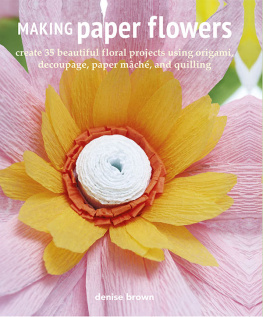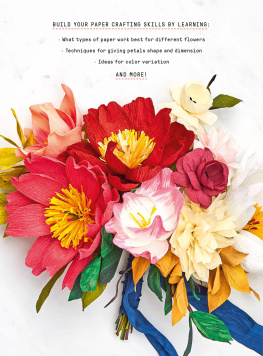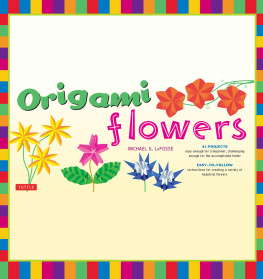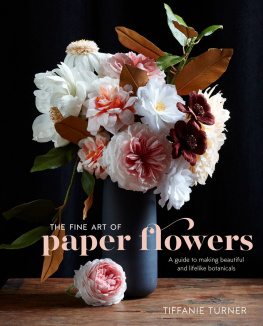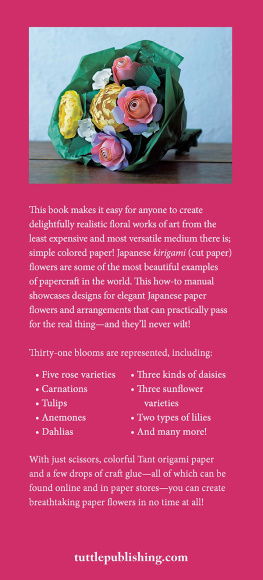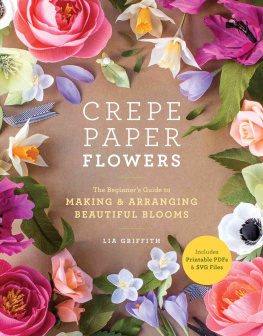

THE EXQUISITE BOOK OF PAPER FLOWER TRANSFORMATIONS
PLAYING WITH SIZE, SHAPE, AND COLOR TO CREATE SPECTACULAR PAPER ARRANGEMENTS
LIVIA CETTI
PHOTOGRAPHS BY KATE MATHIS

Editor: Cristina Garces
Designer: Jaspal Riyait
Production Manager: True Sims
Library of Congress Control Number: 2016943706
ISBN: 978-1-4197-2412-1
eSBN: 978-1-68335-004-0
Text and illustrations copyright 2017 Livia Cetti Photographs copyright 2017 Kate Mathis
Published in 2017 by Abrams, an imprint of ABRAMS. All rights reserved. No portion of this book may be reproduced, stored in a retrieval system, or transmitted in any form or by any means, mechanical, electronic, photocopying, recording, or otherwise, without written permission from the publisher.
Abrams books are available at special discounts when purchased in quantity for premiums and promotions as well as fundraising or educational use. Special editions can also be created to specification. For details, contact specialsales@abramsbooks.com or the address below.

ABRAMS The Art of Books
115 West 18th Street
New York, NY 10011
www.abramsbooks.com


CONTENTS
THE GEOMETRY OF NATURE
My creative process, especially that of making paper flowers, comes naturally to me, so putting it into words is always challenging. Reflecting on years of experience and practice, I can say that my sensibility is inspired largely by landscapes and nature and is greatly influenced by the same principles as ikebana, the art of Japanese flower arrangement. I know instinctively which shapes balance or offset form and have discovered how my intuition plays off of natures own mathematical patterns.
When I set out to create a bloom or arrangement from an idea, a feeling, I turn to nature first. I try to see the flower in its most elemental state, and I take time to look at as many varieties of the actual flower as I can find. Then, I try to break the flower down into parts to further envision how the natural elements can be expressed by paper: petals, stamens, leaves, stems, sepals. For me this is very specific, even mathematical. Almost subconsciously, I create flowers that are, in their most simplified form, geometric shapes. Alliums are spheres or globes. Peegee hydrangeas are cones. Lilies of the valley are arcs. Tulips are bells. And my favorite arrangements always mix and match these shapes expertly to create a beautiful assortment of hard and soft edges. Every flower has its own geometry.
This book will teach you how to play with size, shape, color, and texture to create bright and exuberant paper flowers, each more lush and abundant than the last. Within, you will find instructions for creating bold, vibrant single stems in a variety of natural shapes: globes, spikes, bells, saucers, rectangles, cones, and arcs. By thinking of flowers as elemental shapes, it is easier to be free with your techniques and create blooms that are more natural looking and less manufactured. For example, the Hydrangea () is made up of little tubes that together make a fluid, dynamic vine that can be shaped and molded into a natural arc as you go.
Once you start to think of flowers as basic shapes, you can use that knowledge to build bigger, better arrangements. When I begin an arrangement, I like to play around with the blooms to create different effects. Tall spikes add drama, so I love beginning with Delphinium, Lupine, or Coleus. Large rectangles, like the Cyclamen and Bearded Iris, are eye-catching. Once Ive built a foundation with larger shapes, I fill in the holes with medium and smaller shapesthe same pattern you might find looking at a landscape, where the tall trees dominate, the brush fills in the middle, and the pretty grasses complete the frame at the bottom. So I use the Hellebore () for the smaller spaces.
Of course, you begin with shape, but color and texture are part of the picture, too. For arrangements featuring only one type of flower, playing around with color and texture adds another layer of interest. Here, Ive also offered new techniques for painting, dyeing, and even constructing more architectural petals for creating a host of stunning and complex flowers. This unique visual approach allows for lots of creative experimentation, and the option for many, many personal variations of the flower instructions I offer here. I hope youll see your own creative process take shape as you make your way through these wonderful projects and new techniques!
LIVIA

GETTING STARTED
The projects in this book make use of some essential elements of paper flower making, which Ill explain in this chapter. For those of you who read my first book, The Exquisite Book of Paper Flowers, well revisit fundamentals such as cutting templates, taping wires, bleaching and coloring paper, and attaching petals, buds, leaves, and stems, and more. But youll also find a host of new techniques, as the amazing flowers and projects in this book are a little bit more involvedmore blooms, more petals, stronger stems, more complex final flowers. This is great news for you!
The most essential new techniques involve treating your tissue with new mediums. In addition to dipping tissue in bleach, Ive found that simply using water creates a nicely subtle change in the texture of the tissue. And dipping tissue into fabric dye creates vivid two-tone, three-tone, sometimes evenmore-tone options. For example, with dye, a bright pink strip can be made much more variegated, or you can choose to have several different colors all on one strip (see the Bearded Iris on ). The result is a wonderfully complex tissue effect, with the petals both more natural and more fanciful. Plus, not only can you mix your own colors, but the possibilities for color combinations are endless. And, if you need to make a perfect color match, you can achieve it with dye and customize your palette even more, giving you much more freedom to explore!
TOOLS
Over time, Ive gotten comfortable with the tools I use. Here are the ones I use most often, and the ones youll need to make the projects in this book.
| CUTTING MAT
Make sure your mat is at least 18" 24" (46 61 cm).
| FRINGING SHEARS
Though not required to make the projects in this book, these are a good investment. They create a consistent fringe and save the time it would take to make individual fringe cuts.
| GLUE GUN
I prefer the high-heat type because when you attach leaves to the wire stem, the hotter glue creates a better bond, making the leaves less likely to snap off.
Next page

